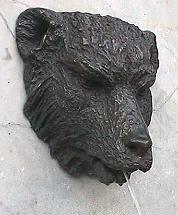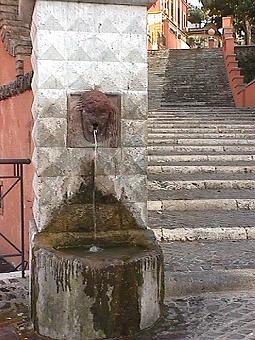OTHER SMALL FOUNTAINS
OF THE 19th AND 20th CENTURIES

fountain with a she-wolf's head |
The nasoni are not the only type of mass-produced
fountain seen in Rome. Around the 1930s, a certain number of white travertine prysms,
whose scanty design is consistent with that of most buildings born during that age,
were made to be set especially in public gardens and parks; also the central area of Rome received a few,
in addition to the pre-existing cast iron cylinders.
As a nozzle, these ones had a bronze she-wolf's head, symbol of Rome. |

one of the few fountains with the fasci |
Several of them are extant, but very few still have the original she-wolf's head which, in the case of damage, was often replaced with a plain pipe (see the picture in the introduction).

above and right, two she-wolf nozzles;
due to an overflow, the one above spouts water
both from its mouth and from the upper hole, located
on the animal's muzzle or (right) between the eyes |
During the same period, a smaller number of fountains decorated with the fasci (a
symbol of the regime of those days) were also made; similar in design to the previous
ones, they had three fasci in green marble on each side, and a plain nozzle (picture above); now only
the trace of the original decoration is left on the very few surviving specimens.
 |
the Fountain of the Artists (for Campo Marzio district)
and the Fountain of the Pine-cone (for Pigna district) |
|
Much prettier than the mass-produced ones are the so-called
district fountains. They form a series of eight, made in 1928 by artist Pietro Lombardi, to whom the municipality
had commissioned the making of small fountains for the benefit of Rome's historical districts
(see The 22 Rioni), each of which inspired by the
features of their own rione.
Only a few sample district fountains are shown in this page, but each of them can be seen
in the relevant page of The 22 Rioni section. |
|
Among Rome's historical districts, Borgo is the only one which has two different
fountains dedicated to its features, one referring to the pope (Fountain of the Tiaras) and one dedicated to Sant'Angelo Castle (Fountain
of the Cannon-balls), although the latter was not among Lombardi's works. |

Fountain of the Cannon-balls (for Borgo district) |
They both draw water from the Acqua Pia-Marcia aqueduct,
whose reopening Pius IX, the last "pope king", had sponsored and given his name. Before the two district
fountains were made, smaller outputs provided Borgo with the same water; among the surviving ones
is a small fountain standing halfway along Borgo Pio. |
|

Acqua Pia-Marcia fountain in Borgo |

the fountain pouring water from the Aqua Virgo |
Furthermore, in the same Borgo district another small output was
opened in the 1800s; this one though is connected to the Aqua Virgo, whose water is considered
to have a better taste than the one from the Acqua Pia-Marcia. It once stood by the no longer
existing Porta Angelica (read more about this gate in The"Popes' Walls,
part I, page 1). When the gate was demolished the fountain was moved to the nearby piazza
delle Vaschette, where it had to be set below the ground level of the square, as the long distance from the main
course of the Aqua Virgo aqueduct (see Aqueducts, page 2)
would have not reached this spot with sufficient pressure, had the output not been
lowered this much. |
|

the triangular fountain
dedicated to
cardinal Riario |
The one in via Paolina features a cherub, in a Renaissance-like fashion
despite being dated 1930 (actually, "Year VIII" of the fascist regime). It is reached by the Acqua Pia-Marcia.
The unusual one in piazza della Cancelleria, made in the same year,
is shaped as a triangle. A large shield pours water into a small basin similar to the
old troughs described in page 1. The shield bears the crest of cardinal Raffaele Riario,
nephew of pope Sixtus IV (1471-84) and founder of the large Chancellery Palace, on the opposite
side of the square (see Rione VI - Parione). Its water comes
from the Aqua Virgo. |

not a Renaissance fountain, despite
the shape: the date reads 1930 |

the small bear fountain |
The third one, of similar age, has a nozzle in the shape of a
bear's head, and draws water from the Aqua Virgo, as the fountain clearly says in Italian ( Acqua Vergine). The bear recalls the Albergo dell'Orso ("Bear Inn", 15th century, see Rione V - Ponte),
which stands at the bottom of the same street. |
 |
Another rather popular output is the one called the Carlotta Fountain. Its name refers to the naive relief of an imaginary woman with long hair, spouting water into a small cylindrical basin. It hangs in a charming corner in the heart of Garbatella, a district built from 1920 to 1929. |
The heavy refurbishments carried out in several parts of central Rome during the early decades of the 20th century left many families without a home; these people were taken to Garbatella, almost as refugees. In fact, in those days this used to be a faraway and rather ill-famed suburb.

the Carlotta Fountain |
In time, though, it was gradually absorbed by the expanding urban area, and well connected to the rest of the city. Since most of its old typical houses are perfectly preserved, it is now one of Rome's most charming districts.
To find the tiny square where the fountain is located may be difficult, even with a map, as the narrow streets of Garbatella are like a labyrinth. But ask any of the local inhabitants how to reach the Carlotta Fountain: they can tell you blindfold!
|
 |
|
Before leaving the realm of small fountains for the more famous and noble ones, built in larger scale, we should not forget to mention an oddity located in the central via Veneto, facing the USA Embassy: the Fountain of the Dog (right).
This tiny output, barely noticed, maybe 60 cm. or 2 feet high, was made by the owner of a nearby bar for the benefit of the pets that stroll with their masters along the famous street of the Dolce Vita. The three letters above the dog's head, ABC, referred to the name of the bar, now no longer there.
* * * |

the Fountain of the Dog |